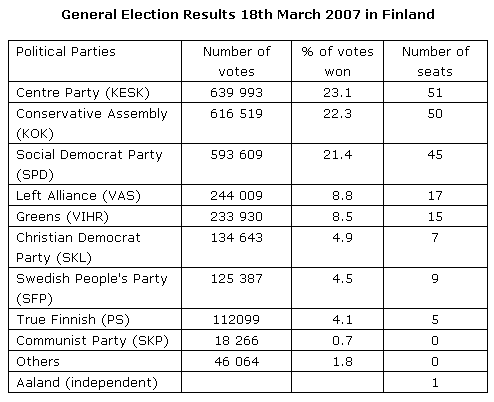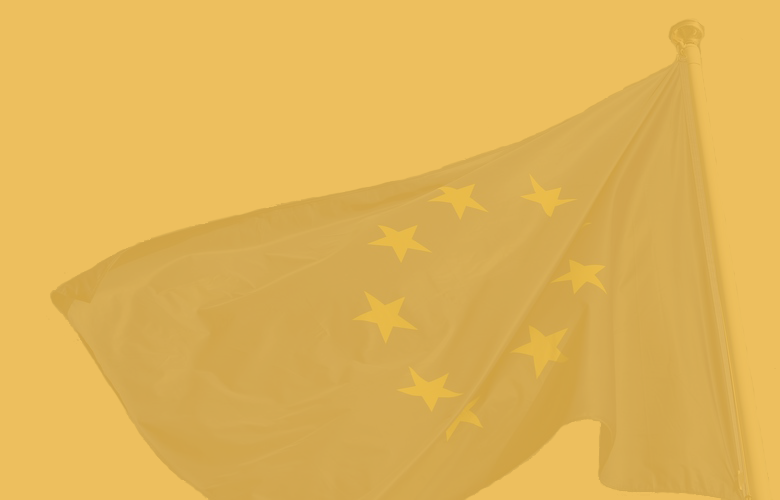News
Corinne Deloy,
Fondation Robert Schuman,
Helen Levy
-

Available versions :
EN

Corinne Deloy
Fondation Robert Schuman
Helen Levy
The Centre Party (KESK) led by outgoing Prime Minister Matti Vanhanen just managed to win the general elections that took place on 18th March in Finland, marking the 100th anniversary of the Eduskunta/Riksdag (the Finnish and Swedish names for Parliament). The KESK won 23.10% of the vote taking 51 seats in Parliament, ie a regression of 1.6 points and four seats in comparison with the previous elections on 16th March 2003. The main opposition party, the Conservative Assembly (KOK) won 22.3% of the vote (+ 3.7 points) and 50 MPs (+ 10). The Social Democrat Party (SPD) lost the most in these elections. With 21.40% of the vote and 45 seats they only came third and this for the first time since 1962 losing 3.1 points and 8 seats. Five other parties will be represented in Parliament: the Left Alliance (VAS) which won 8.80% of the vote (- 1.1 points) and 17 seats (- 2) ; the Greens (VIHR) 8.50% (+ 0.5 points) and 15 seats (+ 1) ; Christian Democrat Party (SKL) 4.90% (- 0,4 points) and 7 seats (-1) ; the Swedish People's Party (SFP), 4.50% (- 0.1 points) and 9 seats (+ 2) and the True Finnish (PS), who have gained territory with 4.10% (+ 2.5 points) and 5 seats (+ 2).
The Centre Party (KESK) has achieved its best result in the region of Oulu (centre of the country) and in Lapland: 43.2% and 43.1% of the vote respectively versus only 6.9% in Helsinki, whilst the Social Democrat won in North Karelia (east of the country), 31.5% and in the region of Satakunta (west of the country), 29.5%. Finally the Conservative Assembly took the lead over its adversaries in the region of Helsinki winning 30.2% of the vote. The Greens achieved 20.1% of the vote in the same part of the country whilst the Left Alliance 23.1% of the vote in Lapland. Finally we should note the high score achieved by the Swedish People's Party in the region of Vaasa (east): 20.6%.
The participation rate rose to 67.9% ie 1.7 points less than during the last general elections on 16th March 2003. The inhabitants of the capital, Helsinki mobilised the most (71.1% participation rate) whilst those on the Aland Islands, a free State associated to Finland only had a 57.1% participation rate. 1, 214, 170 people ie 29.2% of the registered electorate voted early between 7th and 13th March.
"We have succeeded. In an election it is always easy to win coming from the opposition but the most difficult thing is to make a repeat victory. We are first in terms of numbers of votes and seats," jubilated outgoing Prime Minister Matti Vanhanen on Sunday evening. On the announcement of the first results the latter did however maintain, "We are losing in several places. The National Assembly is the obvious winner of the general elections." The major stakes in these elections was indeed to discern the country's leading party since the leader winning the greatest number of votes is traditionally in Finland appointed to start negotiations with the other parties in order to put a future government coalition together and mostly this person is then appointed Prime Minister. The Centre Party is therefore the official winner of the election but its victory is slighter than that forecast by the polls. This is why the leader of the main opposition party was able to claim victory on Sunday evening. "The National Assembly has achieved a major victory. I think it would be strange if we were not to take party in the new government," stressed Jyrki Katainen.
The participation rate, lower than that recorded in the last general elections on 16th March 2003 seems to be one of the main reasons for the decline suffered by the Social Democrats since the leftwing voters were clearly not as mobilised as their adversaries. "The results are not satisfactory. We clearly have not managed to convey our message to the electorate," analysed Finance Minister and Social Democrat leader Eero Heinäluoma, who did appear to be optimistic saying that the question of the formation of the next government remained an "open" one. "Social Democrat voters stayed at home," maintained Tom Moring, Professor of Political Science at the University of Helsinki.
The significant rise of the Conservative Assembly should enable it to enter the next government which is due to be led by the centre. "We are able to co-operate both with the right and the left," declared Matti Vanhanen on 14th March last.
At 51 Matti Vanhanen who originally comes from the town of Jyväskylä in the centre of the country is a graduate of Political Science and Social Sciences. He entered politics with the Centre Party in 1976 and led the party's youth movement between 1980 and 1983, undertaking municipal functions in the town of Espoo (between 1981 and 1984) before returning to journalism in 1985 for the editorial department of Kehäsanomat of which he became editor in chief between 1988 and 1991. In the same year he entered Parliament where he was constantly re-elected for subsequent governments. In 2002, he was appointed member of the Convention for the future of Europe responsible for writing the treaty establishing a Constitution for Europe, a position he left to become Defence Minister of the government led by Anneli Jäätteenmäki (KESK) between 17th April and 23rd June 2003. Anneli Jäätteenmäki, the first woman to lead the government was however obliged to resign accused of having given compromising documents to the press about Paavo Lipponen (SPD), former Prime Minister and candidate for re-election. On 24th June 2003 after only ten weeks of ministerial experience Matti Vanhanen replaced her as Prime Minister.
On 15th January 2006, he came third behind President Tarja Halonen (46.3%) and the Conservative Assembly candidate Sauli Niinistö (24.1%) during the first round of the presidential election winning 18.6% of the vote.
Even though Matti Vanhanen has not said clearly with whom he will govern over the next four years the Conservative Assembly's results should lead to the formation of a more liberal government than the last. The Social Democrat Party which was beaten for the first time in forty-five years by both rightwing parties should therefore find itself on the opposition benches that it left behind in 2003. "Discussions will be very difficult. The programmes will be decisive," declared Matti Vanhanen who maintained that the new government coalition might also include two other "small" parties. "I think it would be good for the government to have between at least 115 and 120 seats in Parliament," he stressed. The change in government should not however lead to major changes in Finland's domestic or foreign policies, since economic and social issues are the subject of a wide ranging consensus between the country's three main political parties.
Parliament will elect the Prime Minister on 17th April and the President of the Republic, Tarja Halonen, will officially appoint the government two days later
 Source www.vaalit.fi
Source www.vaalit.fiOn the same theme
To go further
Elections in Europe
Corinne Deloy
—
4 November 2025
Elections in Europe
Corinne Deloy
—
28 October 2025
Elections in Europe
Corinne Deloy
—
14 October 2025
Elections in Europe
Corinne Deloy
—
7 October 2025

The Letter
Schuman
European news of the week
Unique in its genre, with its 200,000 subscribers and its editions in 6 languages (French, English, German, Spanish, Polish and Ukrainian), it has brought to you, for 15 years, a summary of European news, more needed now than ever
Versions :



